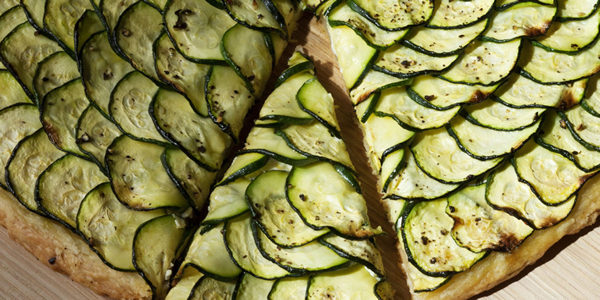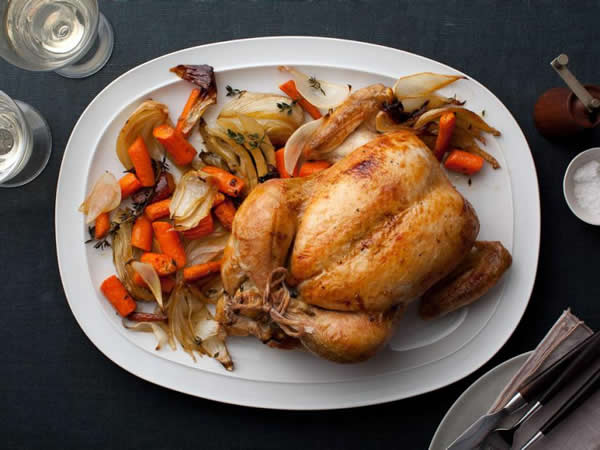Books
Ina Garten’s top 10 recipes
We count down our favorites as beloved cook releases 11th book


Devil’s Food Cake with Coffee Meringue Buttercream (Photo courtesy Food Network)
Like so many home cooks and entertainers, I have followed Ina Garten’s career since her first cookbook, 1999’s “The Barefoot Contessa Cookbook.” The books are beautifully photographed, the recipes easy to follow and the personal anecdotes and tips helpful and illuminating.
Garten famously left a White House job in the 1970s after seeing an ad for a specialty foods store for sale in the Hamptons. After 20 years there, she sold the business and later began writing cookbooks before being convinced to create a companion TV show for the Food Network. And the rest is history. On Oct. 23, Garten released her 11th cookbook, “Cook Like a Pro.” To celebrate, we’re counting down 10 of her best recipes. And, yes, I’ve made them all. (You can find the full recipes online or on the Food Network app.)
No. 10 Roasted Butternut Squash Soup, “Back to Basics.” This is a go-to fall/winter soup and I’ve made it so many times the pages of this recipe in the book are stained with splashes of pureed squash. A guilt-free dish, this one is naturally creamy with a hint of sweetness courtesy of the McIntosh apples. Take the time to make Ina’s homemade chicken stock to really turn up the volume, as she’d say.
No. 9 Greek Feast, “Parties” and “Make it Ahead”. This is several recipes combined to create the perfect Greek dinner. Start with grilled leg of lamb from the “Parties” book, a unique collection of full menus. She marinates the lamb with yogurt and herbs before grilling. Ina’s hummus recipe calls for a mixture of walnuts and pine nuts; for a twist try the butternut squash hummus from “Cooking for Jeffrey.” Her tzatziki is equally simple and the perfect companion for the lamb. Pastitsio from “Ahead” is a Greek lasagna with beef, lamb and lots of other ingredients like cinnamon, cayenne and heavy cream. It’s a filling winter dinner or a heavy side to the lamb. Herb-marinated feta is the perfect starter.
No. 8 French Potato Salad, “The Barefoot Contessa Cookbook.” This is a welcome alternative to the usual mayonnaise-heavy potato salads found in grocery stores in summertime. Garten trades the mayo for a classic vinaigrette and mixes in lots of fresh dill, flat-leaf parsley and basil, which you surely have growing in your summer garden. The recipe is similar to Marcella Hazan’s — and that’s a good thing.
No. 7 Truffled Chicken Liver Mousse, “Make It Ahead.” This is a decadent and updated take on paté that gets a boost from white truffle butter and fresh thyme. It keeps for a week in the fridge but will never last that long.
No. 6 Herb-Roasted Fish, “Make it Ahead.” Often the simplest preparations are the best, which is certainly the case with this dish. It’s one of my go-to’s if I’m cooking for one but works great for a crowd. Use snapper or cod and wrap the fish in parchment paper drizzled with olive oil and lemon juice, add a sprinkle of fresh thyme and Cerignola olives. Then seal the paper into a pocket shape and cook for just 15 minutes at 400 degrees and you have a perfectly cooked, moist and flavorful fish every time.
No. 5 Devil’s Food Cake with Coffee Meringue Buttercream, “Cooking for Jeffrey.” As Ina notes, this cake is a showstopper with four towering layers of chocolate devil’s food. It’s labor intensive, too, and she recommends baking the cakes one day and preparing the frosting the next. The meringue buttercream is legit — no shortcuts involving shortening — so it takes a full hour to properly beat the egg whites at high speed. Don’t cheat, it really does take an hour. This recipe has some pitfalls; be sure the frosting mixture is absolutely at room temperature and never stir the boiling sugar. Take the extra time to frost with a pastry bag and decorate with chocolate-covered espresso beans. It’s massive and serves up to 16 people, who will be wowed when you bring this to the dessert table.
No. 4 Zucchini & Goat Cheese Tart, “Make it Ahead.” This is another one that takes a little patience and practice but the result is a gorgeous tart showcasing thinly sliced zucchini (use a mandolin) arranged in tight circles. Ina adds vinegar to the crust, which she says makes it flaky (it does). Makes a perfect appetizer or light lunch.

Ina’s Zucchini & Goat Cheese Tart (Photo courtesy Barefoot Contessa)
No. 3 Boeuf Bourguignon, “Barefoot in Paris.” My favorite of her books is “Paris,” showcasing Garten’s preference for French cuisine. As she notes in the recipe, boeuf Bourguignon can be tough and stringy as it’s often overcooked. The solution? Cook it in 90 minutes. And don’t forget to stand back when adding and igniting the cognac. This one tastes better the next day, so make it in advance and reheat for an easy dinner party.
No. 2 Make-Ahead Thanksgiving Dinner, “Make It Ahead.” Garten takes the stress out of cooking Thanksgiving dinner in this book, which offers options for the full meal. Forget all the debates about how to cook the perfect turkey – bag or no bag? Breast down or up? High temp or low temp? Baste or no baste? — Garten has the surprisingly simple answers (325 degrees for two hours). I prepared this menu a few years ago for a party of 18 and was nervous as it was my first time cooking such a large bird. When the timer buzzed, a crowd gathered round the oven; I opened the door and removed the golden-brown, perfectly cooked turkey to oohs and ahhs. Serve it with her turkey gravy with onions and sage (which freezes for up to three months) and leak and artichoke bread pudding (perfect substitute for traditional stuffing).
No. 1 Perfect Roast Chicken, “Barefoot Contessa Cookbook.” Ina is perhaps best known for her many excellent chicken dishes, including Tuscan lemon and mustard roasted chicken. Her roast chicken with radishes will have you convinced the radishes are potatoes if you’ve never roasted one before. But you can’t beat her classic roast chicken from her very first book. It’s famously her husband’s favorite dish. One recurring theme in Ina’s cooking is her use of salt and it’s essential here, liberally sprinkled inside and outside the bird. She stuffs it with lemon, garlic and thyme. The key to cooking most meat and poultry is to let it rest long enough for the juices to get dispersed throughout. As Ina would say, “How easy is that?”
Honorable mentions: Chocolate Chunk Blondies (“Foolproof”); Caramelized Bacon (“Make it Ahead”); Italian Seafood Salad (“Foolproof”).

Ina’s Perfect Roast Chicken (Photo courtesy Food Network)
Books
New book offers observations on race, beauty, love
‘How to Live Free in a Dangerous World’ is a journey of discovery

‘How to Live Free in a Dangerous World: A Decolonial Memoir’
By Shayla Lawson
c.2024, Tiny Reparations Books
$29/320 pages
Do you really need three pairs of shoes?
The answer is probably yes: you can’t dance in hikers, you can’t shop in stilettos, you can’t hike in clogs. So what else do you overpack on this long-awaited trip? Extra shorts, extra tees, you can’t have enough things to wear. And in the new book “How to Live Free in a Dangerous World” by Shayla Lawson, you’ll need to bring your curiosity.

Minneapolis has always been one of their favorite cities, perhaps because Shayla Lawson was at one of Prince’s first concerts. They weren’t born yet; they were there in their mother’s womb and it was the first of many concerts.
In all their travels, Lawson has noticed that “being a Black American” has its benefits. People in other countries seem to hold Black Americans in higher esteem than do people in America. Still, there’s racism – for instance, their husband’s family celebrates Christmas in blackface.
Yes, Lawson was married to a Dutch man they met in Harlem. “Not Haarlem,” Lawson is quick to point out, and after the wedding, they became a housewife, learned the language of their husband, and fell in love with his grandmother. Alas, he cheated on them and the marriage didn’t last. He gave them a dog, which loved them more than the man ever did.
They’ve been to Spain, and saw a tagline in which a dark-skinned Earth Mother was created. Said Lawson, “I find it ironic, to be ordained a deity when it’s been a … journey to be treated like a person.”
They’ve fallen in love with “middle-American drag: it’s the glitteriest because our mothers are the prettiest.” They changed their pronouns after a struggle “to define my identity,” pointing out that in many languages, pronouns are “genderless.” They looked upon Frida Kahlo in Mexico, and thought about their own disability. And they wish you a good trip, wherever you’re going.
“No matter where you are,” says Lawson, “may you always be certain who you are. And when you are, get everything you deserve.”
Crack open the front cover of “How to Live Free in a Dangerous World” and you might wonder what the heck you just got yourself into. The first chapter is artsy, painted with watercolors, and difficult to peg. Stick around, though. It gets better.
Past that opening, author Shayna Lawson takes readers on a not-so-little trip, both world-wide and with observant eyes – although it seems, at times, that the former is secondary to that which Lawson sees. Readers won’t mind that so much; the observations on race, beauty, love, the attitudes of others toward America, and finding one’s best life are really what takes the wheel in this memoir anyhow. Reading this book, therefore, is not so much a vacation as it is a journey of discovery and joy.
Just be willing to keep reading, that’s all you need to know to get the most out of this book. Stick around and “How to Live Free in a Dangerous World” is what to pack.
The Blade may receive commissions from qualifying purchases made via this post.
Books
Story of paralysis and survival features queer characters
‘Unswerving: A Novel’ opens your eyes and makes you think

‘Unswerving: A Novel’
By Barbara Ridley
c.2024, University of Wisconsin Press
$19.95 / 227 pages
It happened in a heartbeat.
A split-second, a half a breath, that’s all it took. It was so quick, so sharp-edged that you can almost draw a line between before and after, between then and now. Will anything ever be the same again? Perhaps, but maybe not. As in the new book “Unswerving” by Barbara Ridley, things change, and so might you.

She could remember lines, hypnotizing yellow ones spaced on a road, and her partner, Les, asleep in the seat beside her. It was all so hazy. Everything Tave Greenwich could recall before she woke up in a hospital bed felt like a dream.
It was as though she’d lost a month of her life.
“Life,” if you even wanted to call it that, which she didn’t. Tave’s hands resembled claws bent at the wrist. Before the accident, she was a talented softball catcher but now she could barely get her arms to raise above her shoulders. She could hear her stomach gurgle, but she couldn’t feel it. Paralyzed from the chest down, Tave had to have help with even the most basic care.
She was told that she could learn some skills again, if she worked hard. She was told that she’d leave rehab some day soon. What nobody told her was how Les, Leslie, her partner, girlfriend, love, was doing after the accident.
Physical therapist Beth Farringdon was reminded time and again not to get over-involved with her patients, but she saw something in Tave that she couldn’t ignore. Beth was on the board of directors of a group that sponsored sporting events for disabled athletes; she knew people who could serve as role models for Tave, and she knew that all this could ease Tave’s adjustment into her new life. It was probably not entirely in her job description, but Beth couldn’t stop thinking of ways to help Tave who, at 23, was practically a baby.
She could, for instance, take Tave on outings or help find Les – even though it made Beth’s own girlfriend, Katy, jealous.
So, here’s a little something to know before you start reading “Unswerving”: author Barbara Ridley is a former nurse-practitioner who used to care for patients with spinal cord injuries. That should give readers a comfortable sense of satisfaction, knowing that her experiences give this novel an authenticity that feels right and rings true, no faking.
But that’s not the only appeal of this book: while there are a few minor things that might have readers shaking their heads (HIPAA, anyone?), Ridley’s characters are mostly lifelike and mostly likable. Even the nasties are well done and the mysterious character that’s there-not-there boosts the appeal. Put everyone together, twist a little bit to the left, give them some plotlines that can’t ruined by early guessing, and you’ve got a quick-read novel that you can enjoy and feel good about sharing.
And share you will because this is a book that may also open a few eyes and make readers think. Start “Unswerving” and you’ll (heart) it.
The Blade may receive commissions from qualifying purchases made via this post.
Books
Examining importance of queer places in history of arts and culture
‘Nothing Ever Just Disappears’ shines with grace and lyrical prose

‘Nothing Ever Just Disappears: Seven Hidden Queer Histories’
By Diarmuid Hester
c.2024, Pegasus Books
$29.95/358 pages
Go to your spot.
Where that is comes to mind immediately: a palatial home with soaring windows, or a humble cabin in a glen, a ramshackle treehouse, a window seat, a coffeehouse table, or just a bed with a special blanket. It’s the place where your mind unspools and creativity surges, where you relax, process, and think. It’s the spot where, as in the new book “Nothing Ever Just Disappears” by Diarmuid Hester, you belong.

Clinging “to a spit of land on the south-east coast of England” is Prospect Cottage, where artist and filmmaker Derek Jarman lived until he died of AIDS in 1994. It’s a simple four-room place, but it was important to him. Not long ago, Hester visited Prospect Cottage to “examine the importance of queer places in the history of arts and culture.”
So many “queer spaces” are disappearing. Still, we can talk about those that aren’t.
In his classic book, “Maurice,” writer E.M. Forster imagined the lives of two men who loved one another but could never be together, and their romantic meeting near a second-floor window. The novel, when finished, “proved too radical even for Forster himself.” He didn’t “allow” its publication until after he was dead.
“Patriarchal power,” says Hester, largely controlled who was able to occupy certain spots in London at the turn of the last century. Still, “queer suffragettes” there managed to leave their mark: women like Vera Holme, chauffeur to suffragette leader Emmeline Pankhurst; writer Virginia Woolf; newspaperwoman Edith Craig, and others who “made enormous contributions to the cause.”
Josephine Baker grew up in poverty, learning to dance to keep warm, but she had Paris, the city that “made her into a star.” Artist and “transgender icon” Claude Cahun loved Jersey, the place where she worked to “show just how much gender is masquerade.” Writer James Baldwin felt most at home in a small town in France. B-filmmaker Jack Smith embraced New York – and vice versa. And on a personal journey, Hester mourns his friend, artist Kevin Killian, who lived and died in his beloved San Francisco.
Juxtaposing place and person, “Nothing Ever Just Disappears” features an interesting way of presenting the idea that both are intertwined deeper than it may seem at first glance. The point is made with grace and lyrical prose, in a storyteller’s manner that offers back story and history as author Diarmuid Hester bemoans the loss of “queer spaces.” This is really a lovely, meaningful book – though readers may argue the points made as they pass through the places included here. Landscapes change with history all the time; don’t modern “queer spaces” count?
That’s a fair question to ask, one that could bring these “hidden” histories full-circle: We often preserve important monuments from history. In memorializing the actions of the queer artists who’ve worked for the future, the places that inspired them are worth enshrining, too.
Reading this book may be the most relaxing, soothing thing you’ll do this month. Try “Nothing Ever Just Disappears” because it really hits the spot.
The Blade may receive commissions from qualifying purchases made via this post.
-

 State Department3 days ago
State Department3 days agoState Department releases annual human rights report
-

 Maryland4 days ago
Maryland4 days agoJoe Vogel campaign holds ‘Big Gay Canvass Kickoff’
-

 Politics3 days ago
Politics3 days agoSmithsonian staff concerned about future of LGBTQ programming amid GOP scrutiny
-

 District of Columbia20 hours ago
District of Columbia20 hours agoCatching up with the asexuals and aromantics of D.C.











